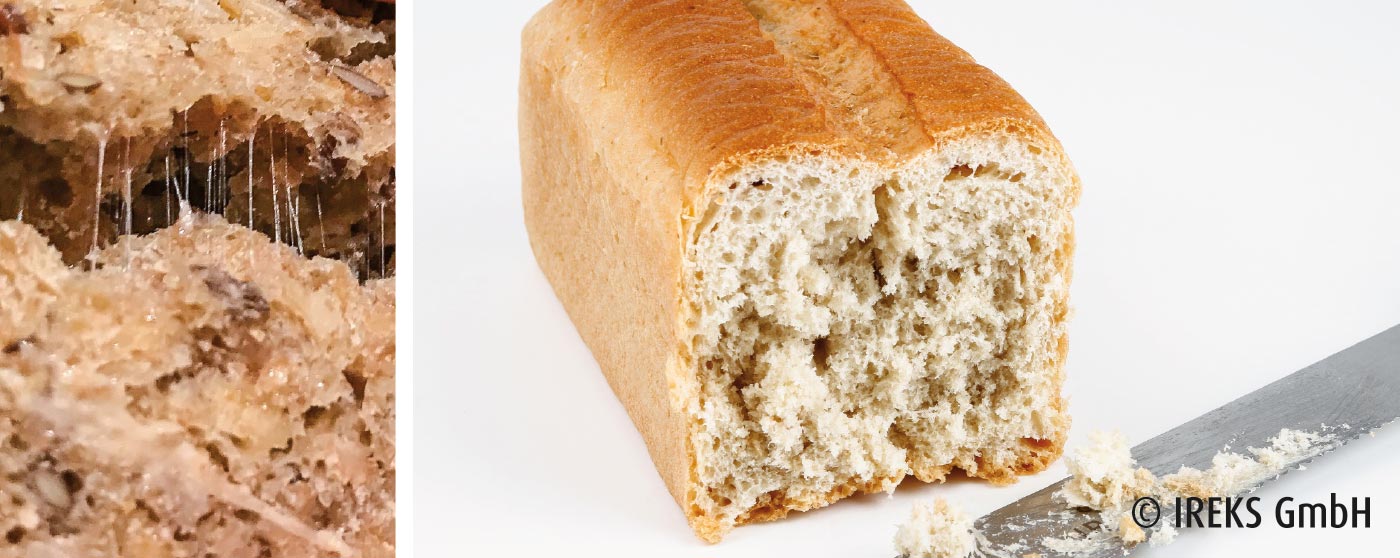The cause of this bread disease is the germination of heat-resistant spores mainly from bacteria of the type Bacillus subtilis, a rod-shaped bacteria. Over and above, other types of Bacillus, such as Bacillus lichenformis, Bacillus pumilus or Bacillus cereus, are also known as possible origins of rope disease. In earlier publications, Bacillus mesentericus has frequently been mentioned. Colloquially, the bacteria is also called hay bacillus or potato bacillus, as the bacteria forming the spores occur in large numbers on grasses and tuberous plants.
The spores can survive temperatures of up to 130° C and therefore the baking process. When cooling and storing the baked goods, the spores germinate. In general, contamination first becomes noticeable after some days, initially by a sweetish, rotten smell of the crumb. Later, the crumb is increasingly decomposed enzymatically and threads like spider’s webs are drawn when it is torn off. Growth is benefitted by high water activity and warm temperatures.
For this reason, rope disease appears more often during the summer months.
Rope disease can appear in wheat bread, mixed wheat bread, yeast-raised confectionery baked goods and baked goods fillings. For the manufacturers of the affected baked goods, rope disease is a real problem because signs of spoilage first appear with the consumer and feedback from the consumers in regard to this fault is not often given.
Baked goods contaminated with rope disease are disgusting and, when eaten, can lead to diarrhoea and vomiting. Due to the influence of acid, the germination and the growth of the spores are delayed greatly. For this reason, rope disease mainly appears in wheat bread which is not acidified and less in acidified mixed wheat bread or mixed rye bread.
The germination and reproduction of the spores are considerably influenced by the pH value of the baked goods. For germination, the spores require pH values of around 6.0. With high rates of contamination and high storage temperatures, the bacterial spores can also germinate with low pH values of up to around 5.4, however.
As effective counter-measures, the use of sourdoughs or dough acidifying agents containing acetic acid has proven its worth. The acetic acid inhibits the germination and the growth of the bacterial spores and the bacteria. Also the salts of the acetic acid, such as sodium diacetate and calcium acetate, offer good protection against rope disease and are therefore often a component of improvers for wheat bread and mixed wheat bread. During the summer months, the salts of the acetic acid are frequently added as an agent against rope disease with a quantity of addition of
0.2 – 0.3 % based on the total flour.
Contamination risks for and contamination sources of rope disease
- during the time of the harvest, spores reach the grain and then the flour via dust from the soil
- use of contaminated leftover bread, which is not acidified, increases the risk of a contamination
Measures to avoid rope disease
- acidify bread adequately
- use dough acidifying agent/sourdough with acetic acid
- regular cleaning and disinfection of bread slicing machines
- ensure rapid cooling of baked goods and do not stack too closely during cooling
- do not wrap baked goods when warm
- use of acidity regulators (sodium diacetate or calcium acetate)
- use of improvers or mixes which contain acidity regulators
- cleaning of all rooms and articles of daily use with a 2 % vinegar solution when contamination with rope disease is ascertained
- use only perfect leftover bread or do without the processing of leftover bread

